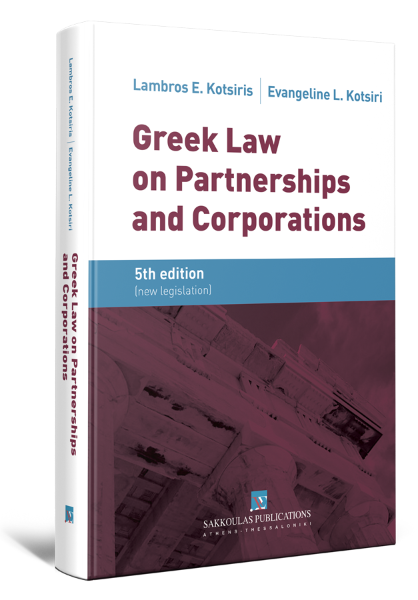L. Kotsiris/E. Kotsiri, Greek Law On Partnerships and Corporations, 5th ed., 2018

Two new Laws have marked 2018 on companies regulation. The new Law 4541/2018 “Amendments of L. 3190/1955” on Limited Liability Companies and other provisions (Off. Gaz. A’ 93/31.5.2018) has introduced deep amendments in the Law 3190/1955, by introducing new provisions in order to update the legal status of the “Limited Liability Company” (etairia periorismenis efthinis “EPE”). Few amendments refer also to the legal status of other commercial companies. More and broad amendments has brought the Law 4548/2018 (Off. G. A 104/13.6.2018) on reformation of the Law on Société Anonyme. This new legislation has abrogated the old legislation (L. 2190/1920 as amended) in order to comply mostly with EU legislation on companies.
Edition info
Table of contents +-
Acknowledgements
Preface
Abbreviations of Greek Law Journals
An Introduction to Greek Commercial Law
Characteristics and History of Greek Commercial Law
Particularity of Commercial Law
Relation to Civil Law
Economy and Commercial Law
Commercial Institutions in Ancient Greek Law
Maintenance Through Customary Law
Introduction of French Code de Commerce
Modifications by New Statutes
Special Jurisdiction in Commercial Disputes
New legislation on R.S.A
Transformations of Companies. Project Law
Partnerships
COMPANY LAW
Chapter
INTRODUCTION
A. General Concepts
The Greek Concept of “Etairia”
Principles of the Greek Company Law
Towards a Development of Company Law
B. Sources
Sources of Company Law
Chapter
Classification of Companies
A. Classification Criteria
The Object of the Company (Substantive Criterion)
The Form of the Company (Formal Criterion)
The Structure of the Company (Structural Criterion)
B. Conceptual Classification
Commercial Companies With or Without Legal Personality
Atypical Company Forms
Abnormal or Factual Companies
Chapter
COMMERCIAL PARTNERSHIPS
A. General Partnership (Omorrythmi Etairia “O.E.”)
1. Introductory remarks. Basic characteristics
Nature and basic features
Formation
Duration
2. Management and Representation
Management
Representation
3. Liability of Partners
Joint and several liability
Prescription
4. Relationships among the Partners
The partnership agreement
Partnership share
Property Rights
Administrative Rights
Duties of the Partners
Exit and exclusion
5. Dissolution and Liquidation
Causes for dissolution
Continuation of the partnership
Liquidation
Revival
6. Prescription
Time limitation
7. Civil partnership with legal personality
Applicable provisions
B. Limited Partnership (Eterorrythmi Etairia “E.E.”)
1. Nature
Basic features
Two kinds of limited partnerships
2. Legal Status of the Limited Partner
No merchant, full partner
The meaning of limited liability
Firm name. The status of the limited partner
Legal status of the limited partner. Management
Right of inspection
Acts of competition
Profits and losses
Dissolution of the partnership
Conversion of a limited into a general partnership
Conversion of a limited liability company into a general or limited partnership
3. Limited Partnership by Shares
New regulation
E.C. Law Harmonization
Nullity of the Partnership
Reference to Provisions Applicable to Companies with Limited Liability
Register
C. Silent Partnership (Aphanes Etairia)
1. Nature
General features of an undisclosed partnership
The legal concept of the silent partnership according to the L. 4072/2012
Formation
No legal personality
2. Internal and External Relationships
Internal
External
3. Dissolution and liquidation
Dissolution
Liquidation
Bankruptcy of the disclosed partner
D. Joint Venture (Koinopraxia)
Voluntary association of enterprises
Legal nature
Joint ventures for construction of public works
General application. The provisions of the L. 4072/2012 on the joint ventures are applicable generally on all joint ventures governed by a specific regulation, unless the relevant regulation provides otherwise (art. 293 § 4 L. 4072/2012)
E. Transitional provisions of the L. 4072/2012
Partnerships concerned. Provisions repealed
F. Taxation of partnerships
Tax rate
Taxation of joint ventures and silent partnerships
Chapter
LIMITED LIABILITY COMPANY (“E.P.E.”)
(L.L.C. or L.T.D.)
A. Sources and Nature
Sources of law
Basic features
B. Formation
1. Constitution
Formality requirements
Minimum mandatory content of statutes and formation
Optional content
2. Payment of Contributions
Arts of contribution
Valuation of in-kind contributions
3. Constitution and Publicity. One-Stop-Service
Constitution procedures
Registration. Publication
Consequences
Pre-incorporation transactions
“Branch” publicity requirements
Disclosure Formalities and Third Party Effects
4. Annulment of the Company
Voidability and grounds
Court decision
Non ex tunc effect
C. Share Capital and Shares
Minimum amounts
Company shares
Equality and transferability
Joint ownership and attachment
D. Organization
1. Management and Representation (administration)
Appointment of managers
Revocation. The appointment of the managers may be revoked. The law makes some distinctions in this regard
Powers
Duties
Liability
2. Members’ Meeting
Powers
Calling
Resolutions taken by a two-tier majority
Voidability of resolutions
3. Annual Accounts and Auditing
Accounts
Auditing and exemption
E. The Legal Status of the E.P.E. Members
1. Rights and Duties
Rights
Duties
2. Liability
Rule and exceptions
Indirect liability
F. Amendment of Statutes and Capital
Statutes
Increase of Capital
Reduction of Capital
G. Transformation and Merger (see general remark p. 13)
Transformation (conversion)
Conversion of an E.P.E. to an A.E
Conversion of an A.E. to an E.P.E
Conversion of a partnership to an E.P.E
Conversion of an E.P.E. to a cooperative
Merger
H. Dissolution and Liquidation
Dissolution
Liquidation
Liquidator
I. Taxation of the E.P.E
Rate
J. “One man” or “single member E.P.E.”
E.C. Harmonization
Constitution requirements
Functioning particularities
Revival of the EPE
Amendment of Chapter 1 of the L. 3190/1955 “Foreign Companies” to “Branches or Agencies of foreign Companies”
Chapter
COMPANY LIMITED BY SHARES
(Anonymous Etairia “A.E.”)
A. Generalities
Basic general characteristics
Sources of law. New legislation
Solution of conflicts
B. Formation
1. Requirements
Stages. Double system
Categories of business entities
Adoption of the Statutes
Subscription of the Share Capital
Authorization
Simplified Formation Procedures
Formation requirements
Digitalisation
Publication
2. Nullity of the Company and Liability of Promoters
Nullity
Effects
Liability of Promoters for Pre-incorporation Acts. Liability of promoters
3. The Concepts of “Subsidiary Company” and “Holding Company”
Affiliated enterprises. Four criteria
Computation of rights
The Concept of a “Holding Company”
C. Share Capital. Shares and Debentures
1. The Share Capital
Amounts of Capital and Shares
b. Payment of the Capital
Full payment
Conditions for partial payment
Valuation of corporate (contributions or in kind) contributions
c. Increase of the Share Capital
Methods
Resolution and proceeding to capital increase
Pre-emptive Rights. Right of preference
Restriction on withdrawal of the preference right. Strict conditions
Partial subscription
Preclusion of Capital Increase by an Administrative Decision
Increase by Conversion of Bonds into Shares. Right to convert
d. Reduction of the Share Capital
Purpose
Conditions for Reducing the Capital
Methods of Reducing the Capital
e. Redemption (or Amortization) of the Share Capital
The Deciding Body
The Procedure
f. Own Shares
Principle
Exceptions
Restrictions
Acquisition by another company
Credits for the Acquisition of Own Shares
Titles to be issued
2. The Shares
Multiple concept
b. Classes of Shares
Classification
Bearer Shares
Registered or Nominative Shares. New Treatment
Share Certificates. Dematerialization
Vinculated registered shares. The statutes of the company may provide that the transfer only of registered shares be subject to an approval whether of the general meeting or the board of directors “blocked” or “restricted” or “vinculated” shares (art. 43 § 1)
Preferred Shares. Preferential rights, cancellation, conversion
Reimbursed Shares
c. Rights Attendant to Share Certificate
Ownership
Pledge
Usufruct
Pre-shares
d. Rights and Duties of the Shareholder
Principles
Administrative Rights, Voting Rights
Property Rights. Right to Profits
Distribution of net profits
Duties of the Shareholders
No liability principle
No merchant qualification
e. Shareholders agreements
Nature and validity
3. Bonds
Definition and Regulations
The Issuance of a Debenture Loan
The issuance of bonds
b. Types of Bonds
Three basic types
Convertible Bonds
Bonds of Participation
Bonds Secured by Mortgage
The Civil Code Regulation on Bearer Bonds
4. Rights of Promotion (“Founders’ Titles”)
Usage and legal nature
Common Promoter’s Rights
Exceptional Promoter’s Rights
5. Requirements for Admission of Shares to Official Stock Exchange Listing
Regulatory framework
Requirements referring to the Company
Requirements referring to the shares
Prospectus
Underwriter’s liability
Admission of debentures to official listing
Authorization
Securitization
D. The Structure of the Company
1. The Board of Directors
Executive organ
b. Appointment, Removal and Filling of Vacancies of Directors
Appointment
Removal and absence of directors
c. Powers and duties
Powers and representation. Delegation
Organic representation
Management
Fiduciary Duties
d. Further Relations Between Director and Company. Contracts and compensation
Transparency and approval of related party transactions (art. 99)
Loans and guarantees
Other Contracts
Compensation
Conflict of interests
Transparency of transactions with connected persons
Duty of trust
e. Liability of the members of the board of directors
The System of Liability
“Civil Code” application
Claims for Damages
The remuneration problem
Remuneration of the members of the Board of directors (art. 109-114).
f. Functioning of the board of directors
Convocation
Place of meeting
Minutes
Quorum and majority
Representation at the meeting
2. The General Meeting of the Shareholders
Meaning of the term
Kinds of general meetings
Powers
Place of meeting
Publication of the invitation for the general meeting
President of the general meeting
b. Rules of Calling and Functioning
Calling the General Meeting
Quorum requirements
Majority required
c. Substantive Rights of Shareholders
Right to Information
Right to Attend
Right to Vote
Rights of shareholders prior to the meeting
Right to participate
Participation in the general meeting from a distance in real time
Participation in the general meeting by correspondence
Attendance of the general meeting by non-shareholders
Representation in the general meeting
Identification
Resolutions of the general meeting
Resolutions of the general meeting without session
Proxy voting
d. Resolutions
Requirements and Effects
Void Resolutions
Voidable resolutions
Non-existent resolutions
Defects of resolutions taken by another way
e. Collective and Individual Minority Shareholders (art. 141-144)
Minority and minority rights in general
Right to Convene an Extraordinary General Meeting (art. 141 § 5)
Right to Adjourn a General Meeting (art. 141 § 5)
Right to Disclosure (art. 141 § 6)
Right to Information
Right to Adopt Resolution by Roll-Call Vote (art. 39 § 7)
Right to Extraordinary Audit (art. 142)
3. Auditors and Accounting
Accountancy law and company law
Appointment of auditors. Auditors are the third body of the A.E
Annual financial statements and annual reports (art. 145-147)
Distribution of Profits
E. Legal Changes of the Company
1. Amendment of the Statutes
Prerequisites
Codification of the statutes
Crossborder transfer of seat
2. Termination and Winding Up of the Company
Dissolution and Revocation of the Authorization
Liquidation. Continuation of legal personality
Organization of the liquidation
Bankruptcy
Revival of the company
Dissolution
Right to repurchase (acquisition)
Branches of foreign companies of member states. Disclosure requirements
3. Transformation (Conversion)
Genuine and abusive transformation
Transformation of an A.E. to a company with limited liability (E.P.E.)
Transformation of an E.P.E. to an A.E
Transformation of a general or limited partnership to an A.E
Transformation of Company limited by shares to a general or limited partnership
F. Merger and Division of the Company
Introduction
1. Merger
Nature of Merger
Methods of merger
a. Merger by Absorption
Statutory definition
The “Draft” Agreement of Merger
Protection of Creditors
Valuation of the Company Property
Formal Requirements for Merger
Consequences of the Merger
Personal Civil Liability
Nullity of the Merger
Unfair Exchange Ratio
b. Special Cases of Merger by Absorption
Absorption of a Subsidiary by a Parent Company
Merger of a Subsidiary by Parent Company Holding 90% or More of its Shares
Acts Similar to the Merger by Absorption (Buying Out)
c. Merger by Formation of a New Company
Absorber new company
2. Division
Nature of Division
a. Methods
Methods of Division
Division by Absorption
Division by Formation of New Companies
Division by Absorption and Formation of New Companies
b. Specific Mechanisms and Requirements for Division
Requirements of Preliminary Stage
Protection of Creditors
Final Phase
Consequences of Division
Nullity of Division
By formation of new companies and by absorption and formation of new companies
3. Facilitated Transformation of Undertakings (L. 2166/1993)
Development incentives (L. 2166/1993)
Merger and division of credit institutions
The Criminal liabilities of companies
Chapter
COMPANIES GOVERNED
BY SPECIAL LEGISLATION
A. Banking Companies
EU law harmonization
National Law
Cooperative Banks
B. Insurance Companies
Basic features
C. Investment - Portfolio Companies and Mutual Funds
1. Collective Investments in Transferable Securities
Introductory Remarks
2. Investment Companies
General Remarks
Specific Establishment Requirements
Specific Obligations during Operation Time
Supervision
3. Mutual Funds
General Remarks
Constitution
Shareholders and Shares
Regulation and Prospectus
The Management Company
The Custodian
Investment Policy
Supervision
Taxation
D. Athletic Companies Limited by Shares
Scope and basic features
E. Companies Limited by Shares with Cooperatives, Municipal and Communal Companies of Laic Basis
Commercial companies
F. Maritime Companies
mixed type of company
G. Cooperative (Synetairismos)
1. Definition and Formation
Definition
Formation requirements
Management Structure
2. Management
General Meeting
Supervisory Board
3. Relationships between the Cooperative and its Members
Membership
Liability
4. Dissolution, Transformation, Liquidation
Grounds of dissolution
Liquidation
Bankruptcy
Revival and Merger
5. Federal Organization and Controlling Authorities
Federated cooperatives
Ministry of National Economy
H. Leasing Company Limited by Shares
Remarks on Leasing Contracts
The Leasing Company
Leasing Contract Requirements
I. Factoring Company Limited by Shares
The Factor
The Factoring Agreement
J. Other Modern Forms of Companies Limited by Shares
Venture participation Capital S.A
Central Depository
EPEY AE
Mutual Guarantee
Chapter
Private Capital Company (I.K.E.) or
Private Company (P.C.)
A. New Company Form. Introduction
The Grounds for Introduction. Grounds
Nature and Basic Features. Nature
Basic Features
B. Formation
1. Requirements.
Three Stages
Adoption of the statutes
Founders-Promoters
2. The Content of the Statutes
Personal Data of the Partner
Firm Name
Registered Office (Seat)
Duration
The Purposes
Further Content Requirements
3. Process of Incorporation
Simplified Process
Legal Personality
4. Provisions of General Importance
Transparency
Dispute Resolution
Nullity
Liability of Promoters for Pre-Incorporation Acts
C. Organic Structure
1. Management and representation
Managers
Kinds of Management
Revocation (Removal) of the Manager
Lack of Manager
Publicity
Powers of the Manager
Duty of Loyalty
Duty for Bookkeeping
Liability of the Managers
2. Decisions of the Partners. Partners Meeting
Competences of the Partners
The Meeting of the Partners
Calling the Meeting
Place of the Meeting
Participation and Decisions Proceedings
Without Meeting Decisions
Defective Decisions of the Partners
D. “Company Shares” and Contributions of the Partners
“Company Shares”
Arts of Contributions
Capital Contributions
Extra- or Non-Capital Contributions
Guaranteeing Contributions
Accounting Following up of the Contributions
Repayment of Contributions
Buying out of Extra-non-Capital and Guaranteeing Contributions
Transfer of Company Shares
Transfer Between Living
Transfer Mortis Causa
Right of Option
Company’s Own Company Shares
Attachment of Company Shares
Entrance of a New Partner
Capital Increase
Capital Reduction
E. The Legal Status of the Partners
General Rule of Rights and Obligations of the Partners
Administrative and Property Rights
Obligations of the Partners
Exit of a Partner
Exclusion of a Partner
Relationships Between the Company and the Partners or the Manager.
F. Annual Account-Profit Distribution-Audit
Annual Accounts
Approval of the accounts and distribution of profits
Consolidated accounts
G. Dissolution and Liquidation
Prospective inability of the company to pay
Grounds of dissolution. The company is dissolved:
Liquidation and liquidator
Activities conducted in liquidation
Revival of the company
H. Conversion (Transformation) and Merger of the Company
Organic Changes in General
Conversion of I.K.E. to Another Company Form
Conversion to other Company Form into an I.K.E
Merger of Private Capital Companies
Special Regulations on I.K.E. Merger
I. Taxation-Adjustment Provisions
Taxation
Adjustment
Bibliography
Index





















